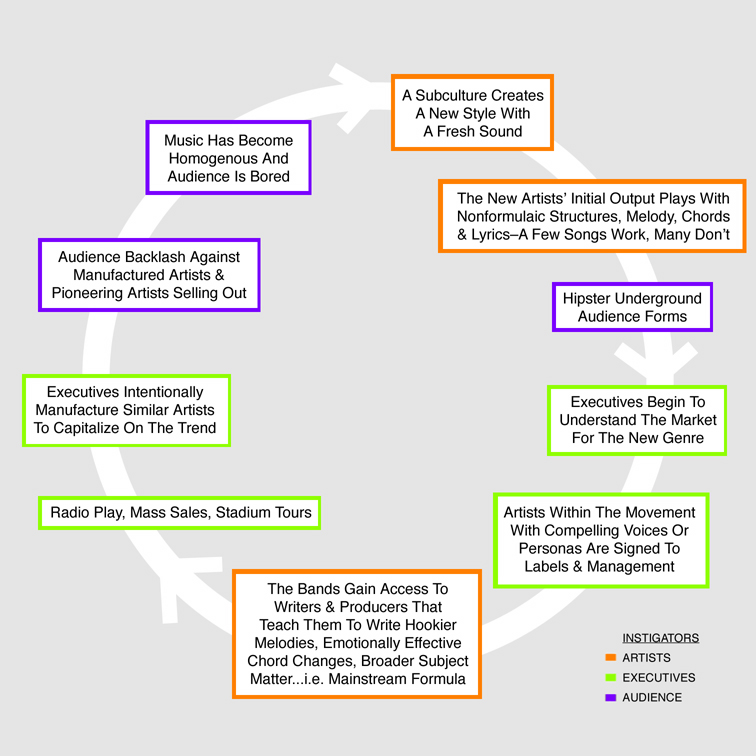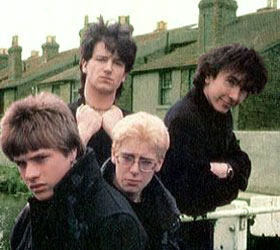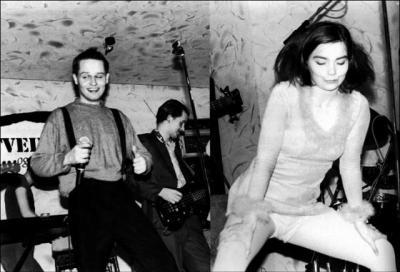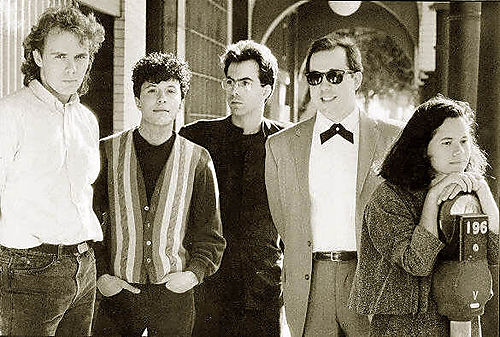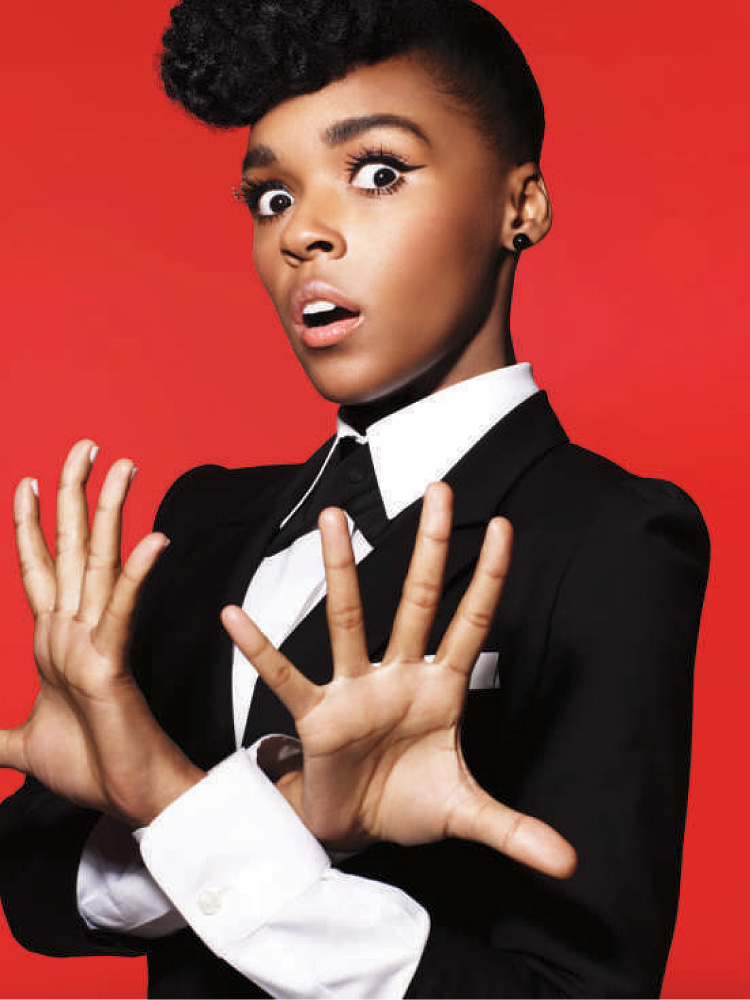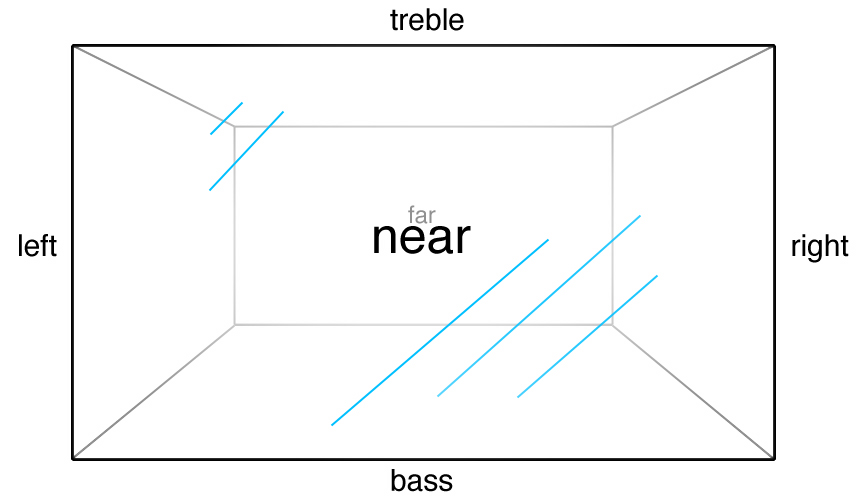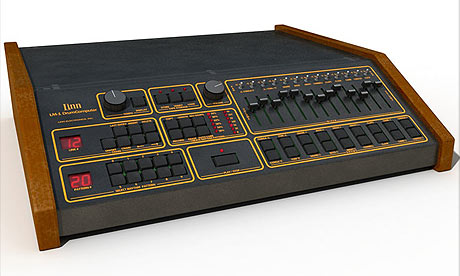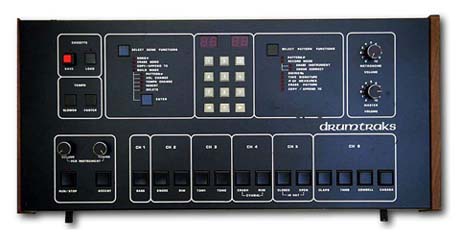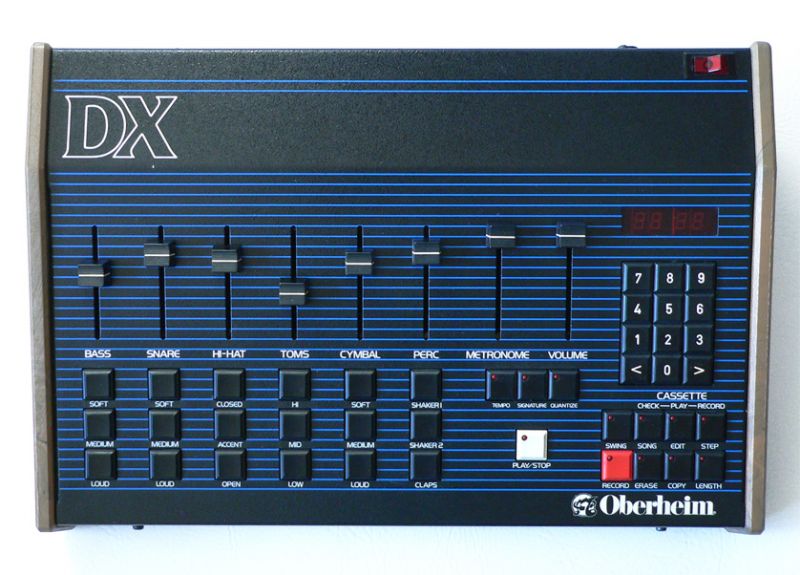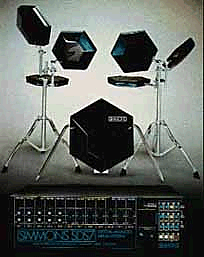Archive for August, 2010
The Creative-Commercial Cycle: How Pop Eats Itself
Posted by Gavin Bradley in Labels, Management, Production, Radio, Writing on August 19, 2010
If it’s agreed that the following creative-commercial cycle occurs continuously in popular music…
…then there are a couple of things I find interesting. Namely, the process by which naturally compelling artists learn to create music with mass appeal, and the fact that this cycle seems to be speeding up as the executives get quicker at identifying and exploiting new trends.
For an example of the cycle, we can look at U2’s output. In the early 80s they had underground ‘alternative rock’ cool factor. The songs on their first two albums Boy and October were somewhat freeform. Melodies were cockeyed and noncommittal, lyrics never too direct. Bono’s voice and Edge’s guitar sound, together, supplied compelling personality. Steve Lillywhite’s production captured the band’s raw electricity without stylizing it.
War and The Unforgettable Fire followed, with ‘Sunday Bloody Sunday,’ ‘New Year’s Day’ and ‘Pride (In The Name Of Love)’ showing the first signs of a desire to write for radio. However, an inspired change in personnel brought a new depth to the sound of that fourth album: ambient visionary Brian Eno and roots musician Daniel Lanois were brought in to produce.
Not surprisingly, the subsequent writing on The Joshua Tree was significantly distilled. The straight-ahead stock chord changes and emotive melody of ‘With Or Without You’ as well as the clear, sweeping subject matter of ‘I Still Haven’t Found What I’m Looking For’ and ‘Where The Streets Have No Name’ brought a mainstream audience to them as if by magnetic pull. If Eno and Lanois hadn’t purposely educated the band about mainstream pop writing, some form of growth-through-osmosis had happened as they opened up their creative circle.
Here’s a wordy section from ‘Drowning Man’ on War, followed by the confidence of the continuously building ‘With Or Without You’.
Since the watershed success of that album and the Rattle & Hum stadium tour–amid their core audience’s protests that the band had sold out–U2 has ridden out the last 20 years in various states of expectation-busting experimentation (Zooropa, The Passengers’ Original Soundtracks project) and pop duty fulfillment (All That You Can’t Leave Behind).
Bjork–who, incidentally, at first used her voice much like Bono had in the early 80s–first helmed Icelandic band Kukl, followed by The Sugarcubes. Her childlike voice and persona showed commercial promise amidst the disarray of the bands’ post-punk art-rock.
Teaming up with respected electronic producer Nellee Hooper, she emerged as a solo artist in 1993 with Debut, securing her place in pop history. The follow-up album was Post. ‘It’s Oh So Quiet,’ the big band single America loved to hate, was as straightforward as she would ever get before making her way back into ever-deeper experimental waters.
Compare the atonal rant from ‘Copy Thy Neighbour’ by Kukl with the soaring melody on the chorus of ‘Hyperballad’.
10,000 Maniacs is an interesting case that I made an effort to crack recently. I always had a like-hate relationship (as opposed to love-hate) with their In My Tribe, Blind Man’s Zoo and Our Time In Eden albums because I never quite understood how a band could sabotage moments of melodic virtuosity with such poorly considered arrangements. Or how such a compelling voice–meaning Natalie Merchant’s vocal instrument as well as the interesting angles she took on the songs’ subject matter–could be ruined by an equal helping of preachy condescension. As well, even after a string of five pop singles (‘Like The Weather,’ ‘What’s The Matter Here,’ ‘Trouble Me,’ ‘These Are Days’ and ‘Candy Everybody Wants,’) the band seemed to retain ‘alternative’ cred. Surely it couldn’t just have been based on their name.
A listen through their early recordings, reissued later on Hope Chest and The Wishing Chair, explained much. Like early U2 and Kukl, these songs are meandering stabs at writing, with hookless melodies, wordy, unclear lyrics and unremarkable chord changes. Also like Bono and Bjork, Merchant’s singular personality came through in her voice and the way she used it. 10,000 Maniacs guitarist Rob Buck, too, had an original style. Perhaps not as iconoclastic as Edge’s, but enough to show promise to a record company like Elektra. The band’s ‘alternative’ roots show in these recordings: in addition to the beginnings of their brand of quirky rock, we’re taken through painful world music experiments in Soca, Zouk and Dub Reggae.
‘Death Of Manolete’ from Hope Chest demonstrates the freedom of their wide-open creativity while the exquisite ‘Dust Bowl’ from Blind Man’s Zoo shows us the focus that took hold by the band’s second album with major label producer Peter Asher.
And so we have the artists, feeling around for something new to chew on, and the executives, racing to learn how to capitalize on a movement, a sound, an idea, a persona. They can’t exist without each other, so I don’t mean to imply that executives are the Cruella DeVilles of the world. But the crops need time to grow before the combine comes along to harvest. And in the age of the internet, traces of new artistic energy are identified and absorbed into the machine with breakneck acceleration.
One such ‘absorption cycle’ that makes me shudder is what occurred somewhere between 1995 and 2008, when Jill Sobule and Katy Perry each released a song called ‘I Kissed A Girl.’ Sobule’s song felt like the honest confession of a woman testing the fluidity of her sexuality. Perry’s felt like a market-researched ‘girls gone wild’ capitalization on straight mens’ fascination with girl-on-girl action. The sincere feminist perspective of artists like Sobule through the early 90s was officially absorbed into the machine when Simon Fuller auditioned British Barbie dolls for the Spice Girls. What was their mantra? ‘Girl Power’? Fast forward a decade, and it’s as though the feminist consciousness of the early 90s never existed. Lillith Fair sales are slipping this summer while the promo machine runs full-tilt for Katy Perry, who’s selling an updated Betty Page wet dream. Well, straight men still pull the budgetary levers at the major labels.
I was never fond of the smugly-named British band ‘Pop Will Eat Itself.’ As this creative-commercial cycle accelerates, however, I’m beginning to wonder if they were onto something. Adding momentum to this cycle is the fact that music went post-modern about 20 years ago. That is, sampling signified the gradual decline of truly new forms of pop music in favour of mixing original combinations of retro styles. If artists’ formulas weren’t made of old ingredients, it would be that much harder for executives to hack the recipe.
The ‘no rules’ artist to watch at this moment is Janelle Monae. She’s 24, she’s thoroughly disregarding anything that might be put on her as a female or a person of colour (in her own words: ‘I don’t have to do anything by default’), she’s got a big budget and she’s interesting. And–oh yes–she can sing. She can perform.
Andre 3000 and Big Boi of Outkast began working with her years back, and P. Diddy, of all people, has diverged from pop formula long enough to sign her and give her the kind of backing true artists only dream of in 2010.
Her trip is highly conceptual. Through a four-part suite, she’s reportedly telling the story of a robot named Cindi Mayweather who orchestrates an uprising in Metropolis. Her lyrics are so cryptic, however, that this storyline is barely apparent in the songs. At this early stage her output is coming across as a whole lot of disjointed concept, borrowed from many sources. If Fritz Lang doesn’t turn over in his grave at her shameless appropriation of his story, other visionaries like James Brown might. Virtually every song ends up a pastiche of the styles of several decades over the last century.
Melodically, the material is somewhat flat, the most memorable hooks lifted from elsewhere. Near the beginning of ‘Many Moons,’ a single from 2008’s Metropolis: The Chase Suite, she blatantly bites a riff from the Sesame Street pinball song we all know. After escaping the distraction of the very high budget of the ‘Many Moons’ video, it struck me that the most memorable moment of the song itself was that riff.
Selections from the new album, The ArchAndroid, include: ‘Cold War,’ its arresting single-shot video summoning the moment Sinead O’Connor shed a single tear for the camera in ‘Nothing Compares 2 U’; ‘Tightrope,’ with its main ‘on the scene’ hook lifted from ‘Sex Machine,’ (something she appeared to cop to as she donned a James Brown cape while performing it on David Letterman); ‘Sir Greendown,’ something like Shirley Bassey singing a version of ‘Moon River’; and ‘Make The Bus,’ like an outtake from David Bowie’s 70s trilogy produced by Brian Eno.
Another album track, ‘Locked Inside,’ feels good because it’s written over the chords of Stevie Wonder’s ‘Golden Lady’. It’s all crammed in there, cryptic and disorganized, from cabaret to hot jazz horns and 80s hip hop. And though it’s the work of an artist getting her bearings, both overdoing the concept and underdoing the original substance, she does appear to have the potential to change the game.
In order to keep that high budget record deal so she can mature creatively, it’s important that she have a bonafide hit sometime soon. And for that to happen the songs may have to fit into a framework that people understand a little more readily. There’s the catch-22: before the artist can ignore creative boundaries and lead the way, it seems she must first learn to simplify her writing. In days gone by labels could allow an artist several albums to reach a commercial stride. These days, it’s possible that other executives may be able to pinpoint what’s special about Monae early on and manufacture other acts that are capable of overtaking her. Hurry, Janelle, hurry and grow your garden!
Pressed Up Against The Glass: Visualizing And Discussing Sound
Posted by Gavin Bradley in Engineering, Mixing, Production on August 11, 2010
In 1966, during the recording of ‘Tomorrow Never Knows’ for the Beatles’ Revolver album, John Lennon came up with a request phrased in the language of an artist: ‘I want my voice to sound as though I’m a Lama singing from a hilltop in Tibet’.
Producer George Martin had to interpret this request and come up with a concrete plan of action, which he then had to describe in technical terms to the recording engineer, Geoff Emerick, and the other assistants working under him.
Martin’s plan, documented in BBC’s interviews with George Martin on The Record Producers, was to play back the vocal track through a spinning Leslie speaker inside a Hammond organ and record that. I don’t know if the resulting warbly sound was exactly what Lennon had heard in his mind, but he was delighted with the freshness of the effect.
One of the greatest challenges producers face is coming up with the right language in discussions with artists and engineers. We’re all supposed to be sculpting the same thing. Mixing, for example, involves deciding on the placement of each instrument in a song – from its relative volume and clarity to its spatial positioning in the stereo field. Since we all interpret and describe sound differently, how do we take the seed of an idea born in one person’s esoteric imaginings and explain it clearly to a team?
The right metaphor helps.
A friend with musical leanings (and great skills in metaphor) once told me he likes to feel that he can walk into a recording and move around, visiting each instrument at will. He earmarked Steely Dan’s 1977 offering Aja as a good example of a sonically spacious album.
This idea of being able to ‘walk into’ a mix resonated with me, because I’ve always had a similar visualization of sound: I imagine the song is contained in a big glass box immediately in front of me. Sometimes I describe this model to the people I’m working with so we have a language for discussing our mix decisions.
In this box, a sound can be anywhere, left to right, in the stereo spectrum. It can be low or high, like the bass of a kick drum or the treble of a cymbal. It can be far away because it’s quiet and soaked in reverb (that residual echo of a bathroom or church), or it can be near because it’s loud and dry (just the direct sound with no reverb).
Trends in mix aesthetics come and go, and most of them are set in motion by an advance in technology. In the 60s drums were fed through analog compressors that tended to add a pleasing distortion, and big boxy reverbs were thrown on vocals using a huge room called an echo chamber. In the 70s 24-track recording became a reality and elements could be separated and controlled, making lush stereo arrangements possible. Digital reverb boxes came of age in the 80s, and reverb was applied liberally to snare drums and vocals.
Today the trend is for both of those elements to be almost completely dry. And recordings are significantly louder these days because with new digital compression plug-ins we can make each element much louder than we ever could in analog.
However when this is the case, as a listener I get the sense that the sound is aggressively being pushed out toward me–and pressed up against the glass–rather than inviting me in to explore. In fact I don’t like to be aware that there is a piece of glass between me and the music, but the more compression is used on the sounds in a mix to unnaturally increase their volume, the more obvious it becomes that the sound is hitting a wall, a limit. (Compression is explained beautifully in this two-minute video on the loudness war.)
This loudness war created a connundrum for radio stations that play both old and new music. Because their broadcast machines are calibrated for the loudness of newer material, older music sounded weak in caparison. That is why, a few years back, many major labels began remastering older music at higher levels in an effort to keep their catalogs in rotation–and to sell the same albums all over again to hardcore fans. Even if this meant the music sounded one-dimensional.
While striving to satisfy radio stations’ technical expectations, I look for ways to limit my participation in this ‘loudness war’ because aggressively mixed music tends to induce listener fatigue quickly. I want people to be able to put the records I produce on repeat! I listen to a lot of indie rock these days because those producers seem to have learned the subtleties of the new technology and found ways to make things impactful without flattening them against the glass in an obvious way.
My hope is that an upcoming technological breakthrough will steer us back toward utilizing the sonic depth we once valued. Most of the music I go back to exists casually in its space, enticing the listener in rather than forcing itself on them.
The Fate Of The 808
Posted by Gavin Bradley in Production, Remixing on August 3, 2010
The machine has been co-opted countless times to lend street cred to artist branding: early 90s UK techno act christened themselves 808 State; Kanye West dropped it in the title of his disc 808s & Heartbreak. And it’s regularly referred to by name in tracks like–wait for it–’808′ by Blaque. By now, the machine is more famous than some of the artists that use it. When Blaque sings ’cause I’ll be going boom like an 808,’ or Will.I.Am chants ‘we got the beat, that 808′ on the Black Eyed Peas’ ‘Boom Boom Pow’, we know they’re talking about the SUV-shaking kick of the world’s most celebrated drum machine, the Roland TR-808.
Legend has it that, in 1981, fledgling New York producer Arthur Baker travelled out to Jersey to buy a used 808. Roland had been manufacturing the unit for a couple of years, but like many new boxes, years can pass before someone stumbles upon a way to bring the art out of the technology. Baker brought the machine home and, reportedly, not knowing how to program it yet, he used a beat left in its memory by the previous owner as the basis of seminal rap track ‘Planet Rock’ by Afrika Bambaataa & Soulsonic Force, thus lifting the 808 from a potential fate of being a cheap novelty item stacked on pawn shop shelves for eternity. And that is how the disillusioned previous owner of that 808 turned out to be the nameless, faceless originator of that foundational ‘freestyle’ rap beat.
As the 80s progressed simple 808 beats began appearing on R&B jams by monster artists. After a short lull the machine had a strong resurgence in the early 90s, newly realized, in the stuttering double-time swing of ‘miami bass’ and ‘booty’ tracks. Post- millennium, its status as a classic has regularly been reinforced with new rap trends like Plies’ Southern post-booty beats and most recently in the sparse, ultra-high impact production sound of Kanye West and Drake.
Here are the basic, untweaked sounds of an 808.
The low, long tone of the kick drum is what most people recognize first. The clap, snare and cymbal sounds have come to feel like the sleek natural compliment to that low end, and the ‘cowbell’ sound, which bears little sonic resemblance to a cowbell at all, is really some kind of synthesized fifth chord.
Some 808 beats over the last 3 decades: the original freestyle beat of ‘Planet Rock’ by Afrika Bambaataa and Soulsonic Force (1982); straight ahead R&B jams ‘Sexual Healing’ by Marvin Gaye (1982) and ‘Who’s Zoomin’ Who’ by Aretha Franklin (1985); the syncopated miami bass beat on Inoj’s cover of Cyndi Lauper’s ‘Time After Time’ (1998) which incorporates a snare sample from another machine; Southern rapper Plies’ ‘Plenty Money’ (2008); the sparse 808 kick intro ‘Heartless’ by Kanye West (2008); ‘Successful’ by Drake ft. Trey Songz (2009).
In the early 80s Roland made a complete line of something-oh-something units. The 303 was a bass sequencer, initially relegated to the accompaniment of one-man polka bands and the like until it found a perfect home within the rhythms of late-80s acid house and mid-90s techno.
The 909 drum machine also sat, semi-used, until disco re-emerged…re-branded as ‘house’ in the late 80s: the 909 is to House as the 808 is to R&B and Hip Hop. The machine’s solid, pointed kick drum, crisp high hats and full-bodied clap, used together, ushered in the meditative swing of house music. In particular, rolling the 909’s snare in a multitude of syncopated patterns became the thing to do.
The 909 in action: pre-house snare rolls and echoey clap patterns on ‘Pump Up The Volume’ by M.A.R.R.S. (1987); syncopated snare on ‘E.S.P.’ by Deee-Lite (1990); Shep Pettibone’s snare-happy house mixes of ‘Escapade’ by Janet Jackson, ‘Express Yourself’ and ‘Vogue’ by Madonna (1989-90); MK’s 909-heavy remixes of ‘Movin’ On Up’ by M People, ‘Can You Forgive Her’ by the Pet Shop Boys and ‘Heart Of Glass’ by Blondie (1993-95); and a 909-only beat on the Musk Men bootleg of ‘I Never Thought I’d See The Day’ by Sade (1995).
There are a few other early drum machines worth noting for the impact they had on music as we know it.
Roger Linn created the Linn LM-1 in 1980, and it quickly became the go-to machine for pop production in the U.S. and U.K.
The LinnDrum and Linn 9000 models followed, adding a few more sounds to the initial palette.
Countless instantly recognizable beats were programmed on these machines including ‘The Look Of Love’ by ABC, ‘Don’t You Want Me’ by the Human League, ‘Love Is A Battlefield’ by Pat Benatar, ‘Shock The Monkey’ by Peter Gabriel, ‘Dress You Up’ by Madonna, ‘Wanna Be Starting Something’ by Michael Jackson, ‘Mama’ by Genesis and ‘Everything She Wants’ by Wham.
A friend used to joke that Jimmy Jam and Terry Lewis must have had a climate-controlled room with a sleek black box the size of a tank to produce sounds as big and clunky as they used on Janet Jackson’s ‘Control’ and ‘Rhythm Nation’ albums. Evidently, however, the production team often used Linn machines drenched in gated reverb for Jackson’s signature sound.
Prince crafted virtually everything he produced in the 80s with these machines as well as two others, defining a funk sound we all know.
The raw sounds on Sequential Circuits’ Drumtraks sounded like this:
Oberheim’s OB-DX sounded like this:
With a little manipulation (re-pitching the sounds and adding various effects to them) he was able to create a fresh basis for each new song while defining his production sound. In particular, he seemed to use the Drumtraks clap a different way on virtually every track.
Some samples of Prince’s production from ‘Nasty Girl’ by Vanity 6, through a range of his solo work over the decade including ‘Let’s Pretend We’re Married,’ ‘Little Red Corvette,’ ‘Let’s Go Crazy,’ When Doves Cry,’ ‘The Beautiful Ones,’ ‘Raspberry Beret’ and ‘Kiss’:
No tour through notable 80s drum machines would be complete without mentioning Simmons drums. These were actual physical drum kits produced in varying incarnations between 1980 and 1990 with hexagonal electronic pads that triggered a synthesizer box.
Some individual sounds.
The instantly recognizable white noise fakeness shows up sporadically on all kinds of prog rock, new wave and funk. Some examples are the intro to ‘Somebody Told Me’ by the Eurythmics, the whole drum groove of ‘She Blinded Me With Science’ by Thomas Dolby, the accents in the break of ‘Mr. Roboto’ by Styx, and the snare on ‘Word Up’ by Cameo.
